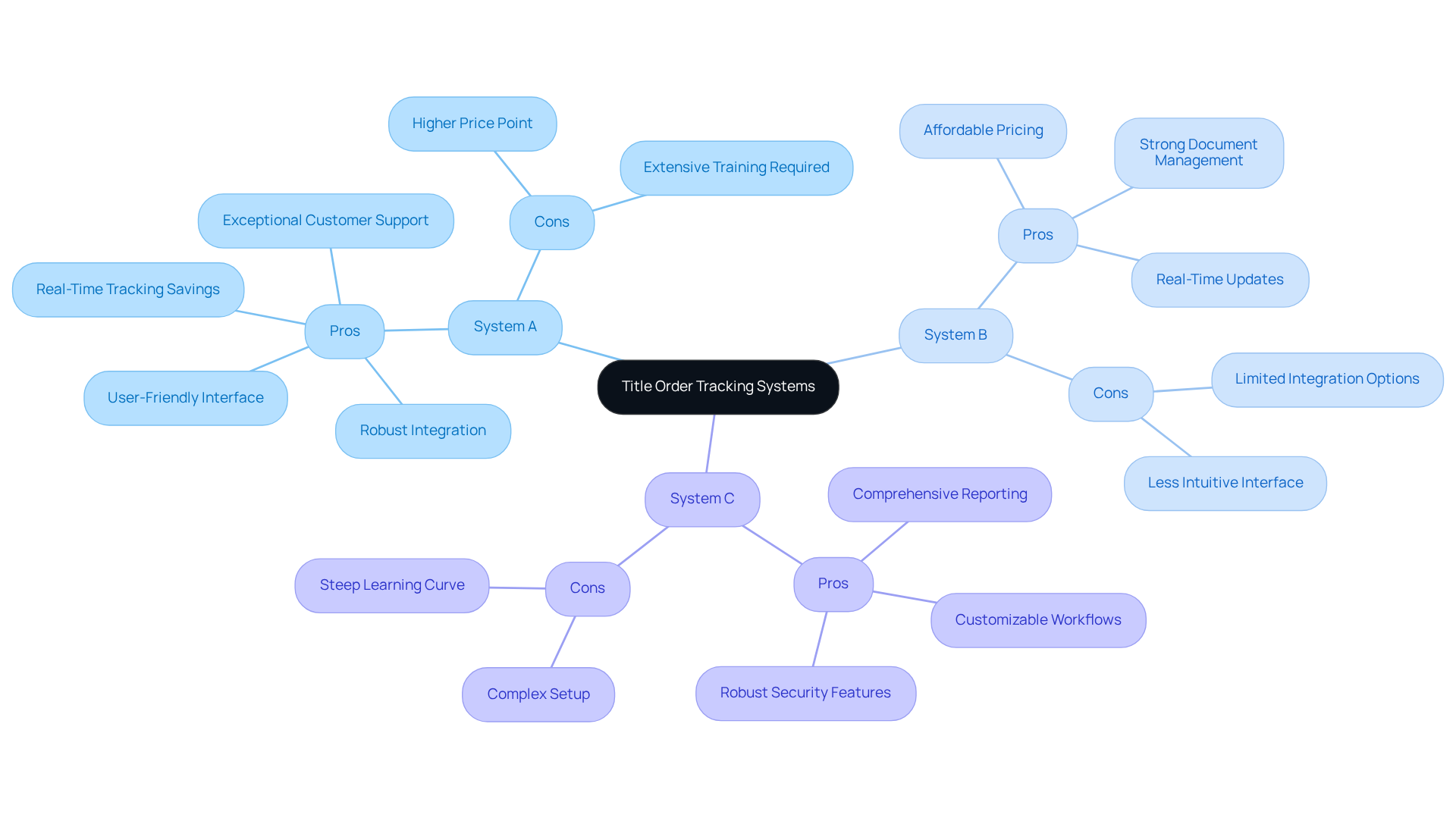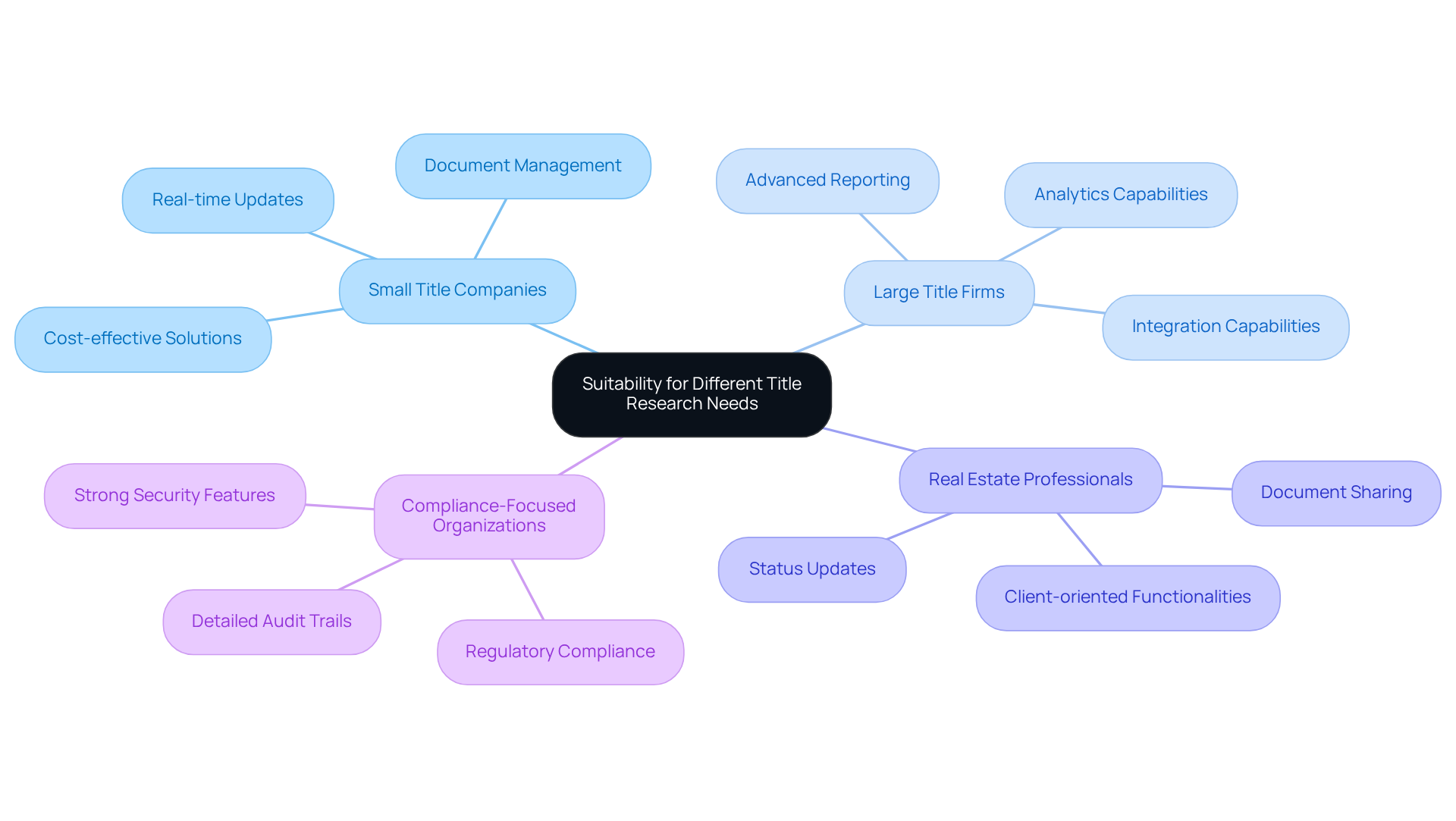Overview
This article examines the significance of accurate title order tracking systems, comparing various options by analyzing their features and suitability for diverse real estate needs. These systems significantly enhance efficiency and communication, providing real-time updates, document management, and integration capabilities. Furthermore, it addresses the specific requirements of small versus large firms, compliance needs, and user preferences. Consequently, this comprehensive evaluation guides informed decision-making in selecting the most appropriate system, ensuring that professionals can navigate the complexities of title management with confidence.
Introduction
Title order tracking systems have emerged as essential tools within the real estate industry, significantly enhancing the management of property transactions and fostering improved communication among stakeholders. These systems not only streamline workflows but also minimize errors and conserve time, rendering them indispensable for firms navigating a rapidly evolving market.
Nevertheless, with a myriad of options available, how can organizations ascertain which system aligns best with their unique needs and operational challenges? This article examines the features, advantages, and disadvantages of leading title order tracking systems, offering insights that empower firms to make informed decisions, thereby enhancing efficiency and client satisfaction.
Overview of Title Order Tracking Systems
Title order tracking systems serve as essential software tools that throughout the research and closing processes. These frameworks significantly improve communication among property firms, real estate experts, and clients, ensuring that all parties remain informed about the status of ownership investigations, document inquiries, and other vital tasks.
By automating numerous manual procedures involved in property research, these solutions drastically reduce errors, save time, and boost overall efficiency in real estate transactions. As the property ownership sector continues to evolve, the integration of advanced technologies such as machine learning and optical character recognition is becoming increasingly prevalent, further enhancing these systems' capabilities.
This technological advancement not only streamlines workflows but also empowers companies in the industry to better address the demands of a rapidly changing market.
![]()
Key Features of Leading Title Order Tracking Solutions
Prominent tracking solutions for documents provide a range of functionalities designed to enhance efficiency and precision in research. The significance of accurate title research cannot be overstated, as it directly impacts workflow and client satisfaction. Key features include:
- Real-Time Updates: Many systems offer instant notifications regarding the status of title orders, allowing users to stay informed without manual follow-ups. Real estate professionals emphasize that the use of title order tracking systems for timely updates significantly improves workflow efficiency and client satisfaction.
- Document Management: Effective document management capabilities enable users to store, retrieve, and share title-related documents with ease, thereby reducing the risk of lost or misplaced files. Given that 97% of companies have minimal to no document management processes in place, effective document management is vital for maintaining productivity, especially since 83% of employees recreate missing documents.
- Integration with Other Tools: Compatibility with additional software solutions, such as CRM applications and document production software, facilitates seamless data sharing and workflow enhancement. This integration is increasingly crucial, as 80% of organizations report that app integration issues hinder their digital transformation efforts.
- User-Friendly Interface: A well-crafted interface enhances user experience, allowing researchers to navigate swiftly to the information they require. This ease of use is essential for maximizing team productivity, as 70% of team members believe that reducing unnecessary meetings and emails would significantly boost their efficiency.
- Reporting and Analytics: Sophisticated reporting capabilities provide insights into processing durations, bottlenecks, and overall effectiveness, assisting firms in identifying areas for enhancement. With 91% of data professionals acknowledging that negatively impact performance, these analytics are crucial for informed decision-making.
![]()
Pros and Cons of Each Title Order Tracking System
When evaluating , it is crucial to understand the advantages and disadvantages of each option for making informed decisions.
System A:
Pros: Features robust integration capabilities with existing title production software, a user-friendly interface, and exceptional customer support, making it a strong contender for firms seeking seamless operations. Furthermore, real-time tracking can save businesses between 5% and 15% yearly, enhancing operational efficiency.
Cons: Comes with a higher price point compared to competitors and may necessitate extensive training for new users, which could impact initial implementation timelines.
System B:
Pros: Offers affordable pricing, strong document management features, and real-time updates, appealing to firms looking for cost-effective solutions without sacrificing essential functionalities. Significantly, 90% of consumers desire the capability to view real-time tracking of their deliveries, which highlights the significance of this aspect.
Cons: Limited integration options and a less intuitive interface may hinder user adoption, potentially leading to inefficiencies in workflow.
System C:
Pros: Provides comprehensive reporting and analytics tools, customizable workflows, and robust security features, making it suitable for firms that prioritize data insights and security. As pointed out by industry specialists, "One of the key pillars of customer satisfaction is transparency," which corresponds with the features of this platform.
Cons: The complexity in setup and a steep learning curve for users unfamiliar with advanced features could pose challenges during the initial rollout.
In a landscape where almost 90% of businesses compete based on customer experience, selecting the right title order tracking systems can greatly impact user satisfaction and operational efficiency. Integrating user input and satisfaction scores is vital, as 85 percent of consumers are inclined to buy again from a business that enables them to monitor their purchases from beginning to end.

Suitability for Different Title Research Needs
Various effectively address the diverse requirements within the real estate sector. For instance, small title companies often benefit from cost-effective solutions that encompass essential features such as document management and real-time updates. Such frameworks enable these firms to optimize operations without necessitating substantial financial investment.
In contrast, larger title firms typically require extensive frameworks equipped with advanced reporting, analytics, and integration capabilities. These attributes are crucial for managing large quantities of orders and navigating intricate workflows effectively.
Real estate professionals, who prioritize communication and transparency, may prefer platforms that offer robust client-oriented functionalities, including status updates and document sharing. This focus enhances client engagement and satisfaction.
Furthermore, compliance-focused organizations that must adhere to stringent regulatory requirements should seek systems with strong security features and detailed audit trails. These capabilities are vital for ensuring compliance with industry standards and maintaining trust with clients.
As the title insurance landscape evolves, the demand for tailored title order tracking systems continues to grow, reflecting the unique operational challenges faced by different types of firms.

Conclusion
Title order tracking systems are vital in enhancing the efficiency and accuracy of real estate transactions. By automating processes and improving communication among stakeholders, these systems streamline workflows and adapt to the evolving demands of the industry. Selecting the appropriate system is crucial for optimizing operations and ensuring client satisfaction.
The article underscores key features of leading title order tracking solutions, including:
- Real-time updates
- Effective document management
- Seamless integration with other tools
It also examines the pros and cons of various systems, stressing the significance of user-friendliness and robust reporting capabilities. Furthermore, the suitability of different systems for diverse business needs is outlined, illustrating how tailored solutions can address the unique challenges faced by both small and large firms.
In a competitive landscape where customer experience is paramount, the choice of a title order tracking system can profoundly impact a firm's operational success. Organizations must carefully assess their specific requirements and consider the features that align with their goals. By investing in the right technology, firms can enhance their efficiency and foster stronger relationships with clients, ultimately paving the way for long-term success in the real estate sector.
Frequently Asked Questions
What is the purpose of title order tracking systems?
Title order tracking systems are software tools designed to enhance the management and oversight of orders throughout the research and closing processes in real estate transactions.
How do title order tracking systems improve communication?
These systems improve communication among property firms, real estate experts, and clients by keeping all parties informed about the status of ownership investigations, document inquiries, and other vital tasks.
What benefits do title order tracking systems provide?
They drastically reduce errors, save time, and boost overall efficiency in real estate transactions by automating numerous manual procedures involved in property research.
How is technology impacting title order tracking systems?
The integration of advanced technologies such as machine learning and optical character recognition is becoming increasingly prevalent, enhancing the capabilities of title order tracking systems.
Why is the evolution of title order tracking systems important for the property ownership sector?
The evolution of these systems is important as it streamlines workflows and empowers companies to better address the demands of a rapidly changing market.




